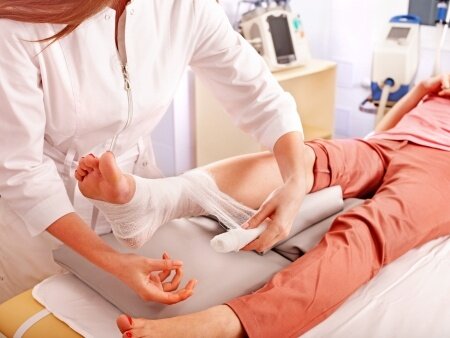You've most likely seen a podiatrist, whether for a foot injury, a fungal infection, or even a routine exam, at some point in your life. Podiatrists are medical practitioners that specialize in diagnosing and treating foot and ankle disorders.
They can assist you with everything from prosthetics and foot surgery to shoe suggestions and preventative foot care. There are several things, however, that podiatrists will not tell you.
They are only sometimes open with information that might assist you in making the best decisions for your foot. Thus, you must be an informed and proactive patient. Don't worry. We'll go through what your podiatrist might not tell you.
1. Nail Salons Cause Foot Infections
A poorly maintained nail salon might do more harm than good on your day off, even if you believe you're treating yourself. This occurs because many nail shops need to follow correct sterilizing procedures.
It is really simple to nick or cut the skin of our hands and feet. It may occur at times when we are utterly oblivious to it. It also contracts germs, fungi, or viruses whenever an open wound touches another person's skin or surface.
When given enough time, they can get infected. Warts and nail fungus are the most frequent diseases contracted at a nail salon. If a salon worker utilizes the same pumice stone on many clients, they risk infecting them with warts.
You may reduce your chance of obtaining warts by using a pumice stone, which most salons stock with fresh ones, or you can bring your own. Go to spas where the staff wears disposable plastic gloves between clients.
Too much callus removal can irritate, cause discomfort while walking, and even infection since calluses provide cushioning for the feet.
In the same way that a cheese grater would shred a block of Parmesan, a callus file would slice your skin, leaving microscopic abrasions that are an open invitation to germs and fungi.
If you end up with a foot infection following a visit to the nail salon, we recommend you get to a podiatrist as quickly as possible. If you’re looking for a Marietta Foot Doctor, we recommend our friends at Ankle and Foot for treatments based out of Georgia.
2. Small Socks Can Cause Blisters
Blisters are more likely to form if the sock is tight and restricts the foot's natural movement. Friction between the foot and the sock is another issue that can arise from wearing too snug socksThis often brings on blisters.
Socks that are too big can bunch up and rub, just like socks that are too little might. Blisters can be caused by poorly fitted socks as well. To provide comfort, socks shouldn't be too loose or too tight.
Socks should be worn to keep your feet warm and dry and reach just above the toes. Your sock material is another something to think about.
Cotton socks are a tried-and-true option because they allow air to circulate and dampen the foot. But nylon and other synthetics can create blisters due to friction.
Socks that are excessively thick or too bulky might do the same by rubbing too much. Invest in socks that fit correctly and are made of a breathable fabric to avoid painful blisters. You can wear decorated socks but ensure they are of good quality and fit you properly.
If your feet are prone to blistering, wear thin, moisture-wicking liners under your socks. And lastly, if you're going to be doing any exercise that involves a lot of walking, like jogging or hiking, then you should change your socks frequently.
3. High Heels Cause Foot Pain
Many women enjoy wearing high heels for various reasons.
High heels, however, can put your foot in an uncomfortable posture, increasing the risk of discomfort and other issues. You have a remarkable bodily component in your feet.
It functions to disperse your body weight and dampen the impact your body takes if you rush or land awkwardly. Putting on high heels causes you to lean forward.
This shifts the bulk of your body weight to the ball of your foot, and the tips of your toes. The balls of your feet might feel an extra 22% pressure from even a low heel.
High heels also alter your walking and standing form. Bunions, hammertoes, plantar fasciitis, calluses, and Morton's neuroma are some of the foot problems that can develop with excessive shoe use.
It is critical to pick the correct shoes to reduce the hazards of wearing high heels. Check if the shoes are comfy and have adequate padding.
Shoes with hooked toes or that are overly tight should be avoided. Check that the heel is moderately high and the shoes are correctly fitted. Wear high heels for brief periods and pause throughout the day to relax your feet.
4. Feet Are an Indicator of Overall Health
Your feet can reveal much about your overall health or alert you of underlying health issues. From annoying foot discomfort to more severe symptoms like numbness, your feet typically show illness signs before other portions of the body.
These signs may be an early warning indicator of more serious health issues. Struggle with persistent foot pain or cramping. Possible causes include dehydration and dietary deficits.
This symptom is prevalent among athletes and helps trainers diagnose dehydration or nutritional deficiencies. Common foot sores can also be caused by wearing shoes, stockings, or other footwear that is too tight or too loose.
These sores are not a severe issue unless they do not heal. A constant sore can indicate high glucose levels, and an open wound that cannot heal may lead to severe infection.
Increased blood flow to the feet is crucial for overall wellness. Though gravity helps pump blood to the toes, good circulation is what really makes sure all that blood makes it safely back to the heart.
Blood flow is increased all across the body when you wiggle your toes. Tight shoes act like braces by subduing the feet and inhibiting normal circulation and movement. This is especially true of shoes with tiny toe boxes or too supportive arches.
5. Measure Feet Size Before Buying Shoes
Although it may be tempting to go by your typical shoe size, take the time to measure your feet carefully.
To achieve the most excellent fit and prevent potential pain or even injury from wearing shoes that don't fit right is critical.
Having the proper shoe size is also essential for your overall comfort. A shoe that is too tiny may squish the toes together and create discomfort. In contrast, a shoe that is too large may result in the foot not being maintained in the proper position and excessive movement within the shoe.
The most straightforward approach to guarantee that you have the right size shoes is to measure your feet correctly. This is accomplished by standing on paper and tracing your feet with a pencil.
When doing this, ensure your weight is uniformly distributed and the pencil is kept near the foot to provide an exact outline. Once completed, measure the length and breadth of each foot to establish your shoe size.
It is crucial to remember that you may need a different shoe size for each foot. Since one foot may be greater than the other, it is critical to measure both feet and pick a shoe size based on the size of the larger foot.
6. Buy from Specialty Shoe Stores
Finding the proper shoe is critical to your general well-being and reducing the chance of ankle discomfort. The right pair can also assist in avoiding injuries and influence how much you enjoy jogging.
But, with so many options available, how do you know which shoe is ideal for you and where to go to find your perfect match? Going to a specialized active shoe store is the right approach if you want the perfect fit.
Staff at specialty shoe businesses are often well-versed in shoes and their attributes. They can provide you with vital advice, such as which shoes are ideal for your specific foot shape and size, and assist you in selecting the finest pair for your needs.
They can help you find the best shoe for running/jogging and tell you about any running essentials you need. They may also tell you about the many brands and materials utilized in the shoe's manufacture. This is useful when making an educated purchase decision.
Higher-quality shoes are more likely to be found in specialty stores than in department stores. This is due to their emphasis on selling shoes produced using superior materials and production processes. This implies the shoes you buy will be more robust and last longer.
Customers may save money by shopping at specialty retailers that provide competitive rates on shoes. Furthermore, many specialty businesses offer discounts and deals on certain goods, saving buyers even more money.
Final Words
Your feet are essential to your body, yet so many people ignore them. Podiatrists are physicians who specialize in evaluating, treating, and treating foot and ankle ailments.
There are several things, however, that your podiatrist may need to tell you. As a result, we set out to address the six things you need to know to make better decisions about your foot and ankle health.


























